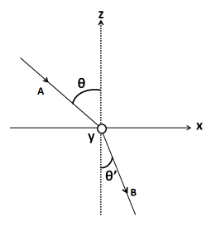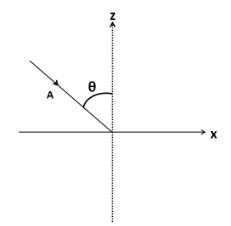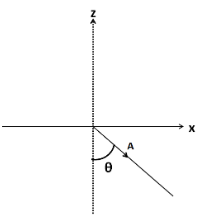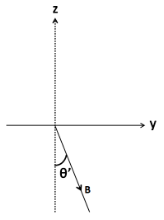
Write the vector representation of the vectors $ A $ and $ B $ with respect to the frame of reference shown in the figure.

(A) $ \vec A = A\sin \theta \hat i - A\cos \theta \hat k $ , $ \vec B = B\sin \theta '\hat j - B\cos \theta '\hat k $
(B) $ \vec A = A\sin \theta \hat i - B\cos \theta \hat k $ , $ \vec B = A\sin \theta '\hat j - B\cos \theta '\hat k $
(C) $ \vec A = B\sin \theta \hat i - A\cos \theta \hat k $ , $ \vec B = B\sin \theta '\hat j - A\cos \theta '\hat k $
(D) $ \vec A = B\sin \theta \hat i - B\cos \theta \hat k $ , $ \vec B = A\sin \theta '\hat j - A\cos \theta '\hat k $

Answer
552.6k+ views
Hint : To solve this question, we need to consider the angles of inclination of the vectors with one axis. Then, multiplying the magnitudes with the cosine and the sine of the angle will respectively give the components along that axis and perpendicular to that axis.
Complete step by step answer
The vector $ A $ is lying in the x-z plane. Therefore, it will have two perpendicular components; one along the direction of the x axis, and the other along the direction of z axis.
Separating the vector $ A $ out of the figure given in the question, we have

For taking the components, we have to do this vector $ A $ co-initial with the unit vectors, $ \hat i $ and $ \hat k $ . Redrawing the above figure, we get

As we can observe, the angle made by vector $ A $ with the x axis is
$ \varphi = \left( {\dfrac{\pi }{2} - \theta } \right) $
As this angle is in clockwise direction, so we take it to be negative. Therefore
$ \varphi = - \left( {\dfrac{\pi }{2} - \theta } \right) $ ………………….(1)
Now, the component of $ A $ along the x axis is
$ {A_x} = A\cos \varphi $
From (1)
$ {{\rm A}_x} = A\cos \left[ { - \left( {\dfrac{\pi }{2} - \theta } \right)} \right] $
We know that $ \cos \left( { - x} \right) = \cos x $ . Therefore, we get
$ {{\rm A}_x} = A\cos \left( {\dfrac{\pi }{2} - \theta } \right) $
$ \Rightarrow {{\rm A}_x} = A\sin \theta $ ………………….(2)
Now, the component along the z axis is
$ {{\rm A}_z} = A\sin \varphi $
From (1)
$ {{\rm A}_z} = A\sin \left[ { - \left( {\dfrac{\pi }{2} - \theta } \right)} \right] $
We know that $ \sin \left( { - x} \right) = - \sin x $ . So we get
$ {{\rm A}_z} = - A\sin \left( {\dfrac{\pi }{2} - \theta } \right) $
$ \Rightarrow {{\rm A}_z} = - A\cos \theta $ ………………….(3)
Now, the vector $ A $ can be represented as
$ \vec A = {A_x}\hat i + {A_z}\hat k $
From (2) and (3)
$ \vec A = A\sin \theta \hat i - A\cos \theta \hat k $
Now, we separate the vector $ B $ out of the given figure

The vector $ B $ is lying in the y-z plane. So it will have two perpendicular components; one along the unit vector $ \hat j $ , and the other along the unit vector $ \hat k $ .
Redrawing the above figure in the y-z plane, we have

As we can observe, the angle made by vector $ B $ with the y axis is
$ \varphi ' = \left( {\dfrac{\pi }{2} - \theta '} \right) $
As this angle is in clockwise direction, so we take it to be negative. Therefore
$ \varphi ' = - \left( {\dfrac{\pi }{2} - \theta '} \right) $ ………………….(4)
Now, the component of $ B $ along the y axis is
$ {B_y} = B\cos \varphi ' $
From (4)
$ {B_y} = B\cos \left[ { - \left( {\dfrac{\pi }{2} - \theta '} \right)} \right] $
We know that $ \cos \left( { - x} \right) = \cos x $ . Therefore, we get
$ {B_y} = B\cos \left( {\dfrac{\pi }{2} - \theta '} \right) $
$ \Rightarrow {B_y} = B\sin \theta ' $ ………………….(5)
Now, the component along the z axis is
$ {B_z} = B\sin \varphi ' $
From (4)
$ {B_z} = B\sin \left[ { - \left( {\dfrac{\pi }{2} - \theta '} \right)} \right] $
We know that $ \sin \left( { - x} \right) = - \sin x $ . So we get
$ {B_z} = - B\sin \left( {\dfrac{\pi }{2} - \theta '} \right) $
$ \Rightarrow {B_z} = - B\cos \theta ' $ ………………….(6)
Now, the vector $ A $ can be represented as
$ \vec B = {B_y}\hat j + {B_z}\hat k $
From (5) and (6)
$ \vec B = B\sin \theta '\hat j - B\cos \theta '\hat k $ -
Thus, the vector representation of the vectors $ A $ and $ B $ are $ \vec A = A\sin \theta \hat i - A\cos \theta \hat k $ and $ \vec B = B\sin \theta '\hat j - B\cos \theta '\hat k $ .
Hence, the correct answer is option A.
Note
The vector $ B $ appears to be lying in the x-z plane. But the options show that it has one component along the unit vector $ \hat j $ . So from there we got to know that the vector $ B $ is in the y-z plane.
Complete step by step answer
The vector $ A $ is lying in the x-z plane. Therefore, it will have two perpendicular components; one along the direction of the x axis, and the other along the direction of z axis.
Separating the vector $ A $ out of the figure given in the question, we have

For taking the components, we have to do this vector $ A $ co-initial with the unit vectors, $ \hat i $ and $ \hat k $ . Redrawing the above figure, we get

As we can observe, the angle made by vector $ A $ with the x axis is
$ \varphi = \left( {\dfrac{\pi }{2} - \theta } \right) $
As this angle is in clockwise direction, so we take it to be negative. Therefore
$ \varphi = - \left( {\dfrac{\pi }{2} - \theta } \right) $ ………………….(1)
Now, the component of $ A $ along the x axis is
$ {A_x} = A\cos \varphi $
From (1)
$ {{\rm A}_x} = A\cos \left[ { - \left( {\dfrac{\pi }{2} - \theta } \right)} \right] $
We know that $ \cos \left( { - x} \right) = \cos x $ . Therefore, we get
$ {{\rm A}_x} = A\cos \left( {\dfrac{\pi }{2} - \theta } \right) $
$ \Rightarrow {{\rm A}_x} = A\sin \theta $ ………………….(2)
Now, the component along the z axis is
$ {{\rm A}_z} = A\sin \varphi $
From (1)
$ {{\rm A}_z} = A\sin \left[ { - \left( {\dfrac{\pi }{2} - \theta } \right)} \right] $
We know that $ \sin \left( { - x} \right) = - \sin x $ . So we get
$ {{\rm A}_z} = - A\sin \left( {\dfrac{\pi }{2} - \theta } \right) $
$ \Rightarrow {{\rm A}_z} = - A\cos \theta $ ………………….(3)
Now, the vector $ A $ can be represented as
$ \vec A = {A_x}\hat i + {A_z}\hat k $
From (2) and (3)
$ \vec A = A\sin \theta \hat i - A\cos \theta \hat k $
Now, we separate the vector $ B $ out of the given figure

The vector $ B $ is lying in the y-z plane. So it will have two perpendicular components; one along the unit vector $ \hat j $ , and the other along the unit vector $ \hat k $ .
Redrawing the above figure in the y-z plane, we have

As we can observe, the angle made by vector $ B $ with the y axis is
$ \varphi ' = \left( {\dfrac{\pi }{2} - \theta '} \right) $
As this angle is in clockwise direction, so we take it to be negative. Therefore
$ \varphi ' = - \left( {\dfrac{\pi }{2} - \theta '} \right) $ ………………….(4)
Now, the component of $ B $ along the y axis is
$ {B_y} = B\cos \varphi ' $
From (4)
$ {B_y} = B\cos \left[ { - \left( {\dfrac{\pi }{2} - \theta '} \right)} \right] $
We know that $ \cos \left( { - x} \right) = \cos x $ . Therefore, we get
$ {B_y} = B\cos \left( {\dfrac{\pi }{2} - \theta '} \right) $
$ \Rightarrow {B_y} = B\sin \theta ' $ ………………….(5)
Now, the component along the z axis is
$ {B_z} = B\sin \varphi ' $
From (4)
$ {B_z} = B\sin \left[ { - \left( {\dfrac{\pi }{2} - \theta '} \right)} \right] $
We know that $ \sin \left( { - x} \right) = - \sin x $ . So we get
$ {B_z} = - B\sin \left( {\dfrac{\pi }{2} - \theta '} \right) $
$ \Rightarrow {B_z} = - B\cos \theta ' $ ………………….(6)
Now, the vector $ A $ can be represented as
$ \vec B = {B_y}\hat j + {B_z}\hat k $
From (5) and (6)
$ \vec B = B\sin \theta '\hat j - B\cos \theta '\hat k $ -
Thus, the vector representation of the vectors $ A $ and $ B $ are $ \vec A = A\sin \theta \hat i - A\cos \theta \hat k $ and $ \vec B = B\sin \theta '\hat j - B\cos \theta '\hat k $ .
Hence, the correct answer is option A.
Note
The vector $ B $ appears to be lying in the x-z plane. But the options show that it has one component along the unit vector $ \hat j $ . So from there we got to know that the vector $ B $ is in the y-z plane.
Recently Updated Pages
Master Class 12 Business Studies: Engaging Questions & Answers for Success

Master Class 12 Economics: Engaging Questions & Answers for Success

Master Class 12 English: Engaging Questions & Answers for Success

Master Class 12 Maths: Engaging Questions & Answers for Success

Master Class 12 Social Science: Engaging Questions & Answers for Success

Master Class 12 Chemistry: Engaging Questions & Answers for Success

Trending doubts
What is meant by exothermic and endothermic reactions class 11 chemistry CBSE

Which animal has three hearts class 11 biology CBSE

10 examples of friction in our daily life

One Metric ton is equal to kg A 10000 B 1000 C 100 class 11 physics CBSE

1 Quintal is equal to a 110 kg b 10 kg c 100kg d 1000 class 11 physics CBSE

Difference Between Prokaryotic Cells and Eukaryotic Cells




